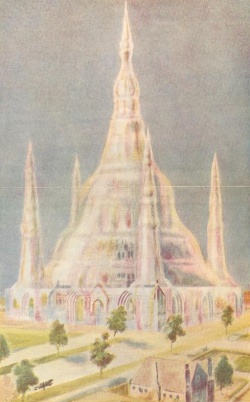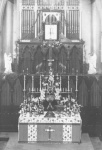Liberal Catholic Church
ARTICLE UNDER CONSTRUCTION
ARTICLE UNDER CONSTRUCTION
Until this article is completed, see the following names of people who were significant in the Liberal Catholic Church (LCC): James Ingall Wedgwood, Charles Webster Leadbeater, Robert Kelsey Walton, Irving S. Cooper, George S. Arundale, Charles Hampton, Felix Layton, and Julian Adrian Mazel.
Early history
Originating in England around 1916, the LCC emerged from a dispute in the Old Catholic Church (OCC) in England, a branch of the OCC in the Netherlands. Archbishop Arnold Harris Mathew ordained a number of Theosophists to the priesthood, knowing them to be Theosophists. However, he later declared that they had to abandon Theosophy if they were to stay in the Church. They rejected the demand and were dismissed from the OCC. They, however, lacked a presiding Bishop to oversee their church activity. Bishop Frederick Samuel Willoughby corrected this lacunae by consecrating James Ingall Wedgwood a Bishop in 1916 and in the same year, Wedgewood consecrated Charles Webster Leadbeater. From that point forward, Theosophists have been very active in the LCC. Yet, they are quick to point out that the LCC and the TS are independent organizations. This assertion, however, does not change the fact that the LCC spread in many ways through the network of the Theosophical Society.
Under the leadership of Wedgewood and Leadbeater, the LCC spread. Moreover, its doctrine and liturgy incorporated the worldview known to Theosophists. In 1920, Leadbeater published The Science of the Sacraments. Within it he details the ways the liturgy not only brings the energy of the Christ to the people through the Eucharist, but also the way the ceremony affects the astral plane. He claims that the Eucharist creates a thought-form that, in the astral, builds a basilica similar to Hagia Sophia in Istanbul. He writes:
The eucharistic thought-edifice to which I have referred is constructed during and largely by means of the due performance of the ritual. This edifice differs somewhat from any of those figured in the book Thought-Forms (1905) though it has much in common with the great music-forms depicted at the end of that work. At a Low Celebration the material for the building is provided by the thought and devotion of the Priest, aided by that of his congregation (if he has any); but at a High Celebration the music and other accessories play a prominent part in its erection, though the celebrant's words and feelings are still the controlling force, and in all cases there is a certain amount of angelic guidance and assistance. This edifice is constructed of matter belonging to various planes—mental, astral and etheric—and at a later stage of the Service the matter of still higher levels is introduced, as will presently be explained. So many factors enter into this manufacture that there is room for wide differences in size, style, decoration and colouring, but the general plan is always recognizably the same. It suggests the shape of a basilica; indeed, it is said that the Church of Santa Sophia at Constantinople was erected in imitation of some of these spiritual edifices.
The completed Eucharist form looks like a church or basilica, with a central structure and four spires or corner columns. Throughout the book, Leadbeater does a detailed analysis of how each part of the liturgy erects a portion of the thought-form. Each part is visually depicted according to Leadbeater’s description, made while clairvoyantly observing the liturgy. Similarly, Leadbeater details the way the vestments channel energetic flow.[1]
Doctrine
Divisions in
Locations
Sydney, Australia
Adyar, Chennai, India
St. Michael and All Saints Liberal Catholic Church' is located on the campus of the Theosophical Society. It was dedicated at the 1937 convention.
Province of the U.S.A.
Los Angeles
The Church of Saint Alban and the Angels was founded in 1917 as the first parish of the Liberal Catholic Church on the west coast of the United States. Bishop James I. Wedgwood ordained Charles Hampton to the priesthood on August 19th, 1917, in a service held in the Krotona Temple. By 1919 there were over 200 members.
The church moved to a new facility of its own, named St. Alban's Pro-Cathedral:
The cornerstone of the St. Alban’s Pro-Cathedral, located on Argyle Ave., was laid on December 4th, 1921. The service of consecration was held on May 7th, 1922, before a crowd of over 400, with Bishop Irving S. Cooper presiding.[2]
San Francisco Bay Area
St. Raphael's Liberal Catholic Church is located in Richmond, California, serving the Bay Area since 1925. Online presence includes a website, Facebook account, Instgram account, and YouTube account.
Ojai, California
Our Lady and All Angels is located in Ojai, California with services on Sundays and Wednesdays. See this website.
Rio Rancho, New Mexico
Our Lady Queen of Angels Liberal Catholic Church is located in Rio Rancho, New Mexico. See website and Facebook account. Services are livestreamed.
Fairfield, Iowa
St. Gabriel and All Angels Liberal Catholic Church is located in Fairfield, Iowa. See website.
Greeley, Colorado
Church of St. Albert is Greeley, Colorado. See website.
Villa Park, Illinois
The Church of Saint Francis is located in the Chicago suburb of Villa Park. See this website and Facebook page.
Orlando, Florida
St. Raphael Archangel Liberal Catholic Church is located in Orlando, Florida. See website. It seems to be independent of the other churches.
Leadership
The Presiding Archbishop in the United States is The Most Reverend William S. H. Downey.
Additional resources
Articles
- Crow, John L. "Theosophy and the Liberal Catholic Church." Religion in American History website. 30 July 2013. Available online at Religion in American History.
- Smoley, Richard, "The Liberal Catholic Church Celebrates Its Centenary," Richard Smoley's Blog (February 17, 2016).
- Liberal Catholic Church in Theosophy World.
Videos
- "What is Liberal Catholicism?" by The Most Reverend William S.H. Downey.
Websites
Notes
- ↑ John L. Crow, "Theosophy and the Liberal Catholic Church," Religion in American History (July 30,2013).
- ↑ "History of the Church of St. Alban". Accessed 9/8/2023.





